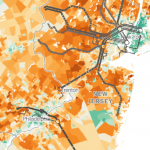New Jersey Future Blog
Electric Yard Goats and Environmental Justice
October 13th, 2021 by Tim Evans

Electric yard goats. Photo credit:
“Electric Yard Goats” may sound like the name of a band (or a baseball team), but they actually represent an important step in New Jersey’s effort to adopt electric vehicles as a means of reducing the transportation sector’s carbon footprint. Furthermore, they can help steer the air-quality and health benefits of vehicle electrification toward communities that have historically suffered the most from pollution generated by gasoline- and diesel-powered vehicles and by the state’s many polluting land uses. (The transportation sector is responsible for 41% of New Jersey’s total greenhouse gas emissions as of 2019, according to the New Jersey Department of Environmental Protection’s Greenhouse Gas Emissions Inventory.)
What is a yard goat, exactly?
Generally, a yard goat is a drivable vehicle designed to move individual freight-hauling containers (truck trailers or rail freight cars) from place to place within the confines of a single property, like a factory, warehouse, or rail intermodal terminal. The vehicles are not powerful enough to haul freight over the highway or rail networks. Rather, they are designed strictly for on-site movement, from one part of the business’s “yard” to another.
In the railroad world, “yard goat” typically refers to a locomotive that operates on a property—not necessarily owned by a railroad—that moves rail cars internally (e.g., a warehouse that needs to move individual cars between loading docks and storage sidings, or a steel mill that uses its own rail cars to move raw materials and intermediate products from one part of the facility to another).
In the trucking world, a yard goat—sometimes called a yard tractor or terminal tractor—is a small truck cab that is used to shuffle around trailers. Ports are major users of yard goats, which pull truck trailer chassis around the property in the process of transferring containers from one mode to another as they arrive from or depart onto the highway or rail network.
Electrifying the busiest port on the East Coast
This is where New Jersey’s new electric yard goats come in. A few months ago, 10 electric yard tractors made their debut at the Red Hook Container Terminal in Port Newark, kicking off a longer-term project to electrify all of the port’s diesel-powered vehicles. This is a significant undertaking, given the port’s environmental footprint and its outsized importance to the state’s economy.
The Port of New York and New Jersey is the second-busiest port in the country and the busiest on the East Coast. Thanks in no small part to the port, the goods movement industry is a pillar of New Jersey’s economy—employing roughly one out of every eight employed New Jersey residents—and is poised to keep growing.
Thousands of shipping containers pass through the port every day, requiring an army of trucks and trains to move them into, out of, and within the port’s various facilities. The port also uses all kinds of on-site cranes to transfer containers from one vehicle to another. All of these machines that keep the containers moving emit a steady stream of pollutants and greenhouse gases into the air. The CO2 emissions are a more widespread problem, contributing to the greenhouse effect that threatens the whole planet. But the more traditional pollutants primarily impact the port’s host towns and their neighbors, many of which are home to large populations of lower-income households and communities of color that have historically been saddled with noxious land uses, like factories and power plants.
Cleaning up past injustices
The Murphy administration has made environmental justice a priority, pledging to end the siting of environmental hazards in neighborhoods where low-income people and/or people of color live—and especially neighborhoods that are characterized by the presence of both low-income households and people of color. The New Jersey Department of Environmental Protection has created and now maintains a list of such “overburdened communities” and is charged with ensuring that state agency actions do not result in the siting of additional noxious land uses in these neighborhoods.
Just as importantly, environmental justice calls for prioritizing overburdened communities when focusing on cleaning up existing sources of pollution. The administration has so far demonstrated a commitment to doing so, as indicated, for example, by the strategies outlined in the Regional Greenhouse Gas Initiative (RGGI) Strategic Funding Plan and the creation of the RGGI Climate Investments Dashboard to track progress in environmental justice communities.
The administration’s blueprint for cutting back the state’s carbon footprint, the Global Warming Response Act 80×50 Report, has placed a strong emphasis on vehicle electrification. New Jersey Future and other groups have pointed out that the state is unlikely to meet its greenhouse-gas reduction goals through vehicle electrification alone, and that we should also be focusing on strategies that reduce people’s need to drive in the first place. But to the extent that vehicle electrification is front and center in the State’s climate strategy, we have argued that the State should prioritize electrifying larger and dirtier vehicles (e.g., transit buses, trucks, and port equipment) in and around neighborhoods that currently suffer from the worst air quality, rather than focusing on building electric vehicle charging stations in upscale suburbs.
The new electric yard goats work toward that goal. The port’s largest facilities are on the New Jersey side of the river in Newark, Elizabeth, and Bayonne. All three of these cities contain many neighborhoods that have historically been on the receiving end of the state’s polluting land uses (all 204 block groups in the city of Newark qualify as overburdened communities, as do 80 of the 82 block groups in Elizabeth and 47 of 52 in Bayonne). The electrification of the port’s many on-site diesel-powered vehicles would thus directly benefit many environmental justice communities via a reduction in airborne pollutants that cause asthma and exacerbate other health problems. Deploying the first round of electric port vehicles represents a small but significant step in the direction of ensuring that the State’s efforts to reduce its future carbon footprint (and clean up other fossil-fuel emissions in the process) actually improve environmental conditions in the communities that have shouldered a disproportionate share of the burden from the state’s industrial past.
Related Posts
Tags: electric vehicles, electric yard goats, environmental justice
















